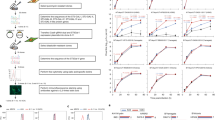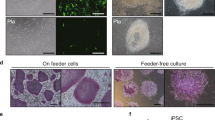Summary
A novel macaque cell line (J3K) with epithelial phenotypes was spontaneously established from a kidney specimen of a Japanese macaque (Macaca fuscata). Its population doubling level reached more than 500, and it was regarded as an established permanent cell line. J3K cells have transformed cell phenotypes such as loss of contact inhibition and anchorage-independent cell growth. Unlike other monkey adherent cell lines, J3K had no SV40 large T antigen. After establishment, cells have constantly expressed telomerase activity, whereas telomere length has been maintained. No mutations in the coding regions of the p53 complementary deoxyribonucleic acid were detected in the late-passaged cells. J3K, a novel transformed epithelial cell line, will be useful material for the comparative study of human and other primate cellular aging as well as cancer cell biology.
Similar content being viewed by others
References
Gluzman, Y. SV40-transformed simian cells support the replication of early SV40 mutants. Cell 23:175–182; 1981.
Hopps, H. E.; Bernheim, B. C.; Nisalak, A.; Tjio, J. H.; Smadel, J. E. Biologic characteristics of a continuous kidney cell line derived from the African green monkey. J. Immunol. 91:416–424; 1963.
Ishida, T.; Varavudhi, P. Wild long-tailed macaques (Macaca fascicularis) in Thailand are highly infected with gamma herpes virus but not with simian T-lymphotropic retrovirus of type 1. Folia Primatol. 59:163–168; 1992.
Kay, H. D.; Mountjoy, C. P.; Wu, G.; Cornish, K. G.; Smith, L. J. Sequence of a cDNA encoding the p53 protein in Rhesus monkey (Macaca mulatta). Gene 138:223–226; 1994.
Kim, N. W.; Wu, F. Advances in quantification and characterization of telomerase activity by the telomeric repeat amplification protocol (TRAP). Nucleic Acids Res. 25:2595–2597; 1997.
Romanov, S. R.; Kozakiewicz, B. K.; Holst, C. R.; Stampfer, M. R.; Haupt, L. M.; Tlsty, T. D. Normal human mammary epithelial cells spontaneously escape senescence and acquire genomic changes. Nature 409:633–637; 2001.
Shimizu, Y.; Ishida, T. Somatic mutations in the p53 gene account for the extension of replicative life-span of macaque cells. Biochem. Biophys. Res. Commun. 295:644–650; 2002.
Wright, W. E.; P.-Smith, O. M.; Shay, J. W. Reversible cellular senescence: implications for immortalization of normal human diploid fibroblasts. Mol. Cell. Biol. 9:3088–3092; 1989.
Author information
Authors and Affiliations
Corresponding author
Rights and permissions
About this article
Cite this article
Shimizu, Y., Ishida, T. Spontaneous establishment of a novel Japanese macaque cell line with epithelial cell phenotypes. In Vitro Cell.Dev.Biol.-Animal 38, 311–313 (2002). https://doi.org/10.1290/1071-2690(2002)038<0311:SEOANJ>2.0.CO;2
Received:
Accepted:
Issue Date:
DOI: https://doi.org/10.1290/1071-2690(2002)038<0311:SEOANJ>2.0.CO;2




